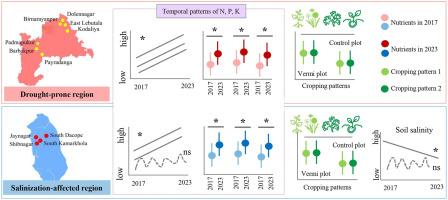用蚯蚓堆肥改造农业:来自孟加拉国干旱易发和盐碱化地区的7年经验证据
IF 10
1区 环境科学与生态学
Q1 ENGINEERING, ENVIRONMENTAL
引用次数: 0
摘要
全球农业生产受到干旱地区极端气候(如干旱)频率增加以及沿海地区土壤和水盐度升高的影响。探索可持续农业实践对于应对气候引发的冲击、恢复土壤肥力和确保粮食安全至关重要。虽然越来越多的证据表明,干旱和土壤盐碱化加剧导致作物损失,但通过土壤肥力恢复提高作物产量的基于自然的解决方案的经验证据仍然有限,而且了解不足。本研究调查了2017-2023年间37个田间试验(11个村庄的22个处理和15个对照地块)的土壤养分(氮、磷、钾)和盐度,研究了蚯蚓堆肥对孟加拉国干旱易发和盐渍化地区土壤养分和盐度(电导率[EC])的影响。结果表明,施用蚯蚓堆肥可降低盐渍化区土壤盐分,提高两区土壤养分含量。在盐渍化影响区蚯蚓堆肥利用试验中,土壤盐度(EC1:5)水平从2017年的5.56 ~ 7.65 dS m-1下降到2023年的4.93 ~ 5.89 dS m-1。施用蚯蚓堆肥的试验土壤盐分和养分含量差异显著,而对照试验土壤盐分和养分含量无明显变化。盐渍化地区(茄子-西瓜、土豆-西瓜)和干旱易发区(茄子-尖瓜、茄子-芝麻)的种植模式对土壤盐分和养分含量的变化均无显著影响。这些结果表明,无论作物组合如何,蚯蚓堆肥都是一种可持续的、多功能的土壤改良剂,可以在不同的农业系统和环境中有效利用。该研究为促进可持续农业实践和利用蚯蚓堆肥改善土壤健康的政策决策提供了经验证据。这些发现为全球可比地区减少土壤盐分和加强可持续农业的战略提供了信息。本文章由计算机程序翻译,如有差异,请以英文原文为准。


Transforming agriculture with vermicompost: 7-year empirical evidence from drought-prone and salinization-affected regions of Bangladesh
Global agricultural production has been affected by the increased frequency of climate extremes (e.g., droughts) in dry regions and heightened soil and water salinity in coastal regions. Exploration of sustainable agricultural practices is central to addressing the impacts of climate-induced shocks, restore soil fertility, and ensure food security. While there is growing evidence of crop losses due to increased drought and soil salinity, empirical evidence on nature-based solutions for increasing crop production through soil fertility recovery remains limited and poorly understood. Investigating the soil nutrients (nitrogen, phosphorus, potassium) and salinity from the 37 field experiments (22 treatments and 15 control plots in 11 villages) over 2017–2023, this study examined the effects of vermicompost on soil nutrients and salinity (electrical conductivity [EC]) in drought-prone and salinization-affected regions of Bangladesh. Results reveal that the application of vermicompost reduced soil salinity in salinization-affected region and enhanced soil nutrient contents in both regions over 7 years. In vermicompost-utilized experiments in the salinization-affected region, soil salinity (EC1:5) levels decreased from 5.56–7.65 dS m−1 in 2017 to 4.93–5.89 dS m−1 in 2023. Soil salinity and nutrient contents showed significant differences among the vermicompost-applied experiments, while no detectable changes in salinity and nutrient contents were found in the controlled experiments. None of the cropping patterns in salinization-affected region (brinjal-watermelon and potato-watermelon) and drought-prone region (brinjal-pointed gourd and brinjal-sesame) had significant effects on the observed changes in soil salinity and nutrient contents. These findings suggest that regardless of the crop combinations, vermicompost is a sustainable and versatile soil amendment, which can be effectively used in diverse agricultural systems and environments. The study provides empirical evidence to support policy decisions aimed at promoting sustainable agricultural practices and enhancing soil health using vermicompost. The findings inform strategies for reducing soil salinity and enhancing sustainable agriculture in comparable regions worldwide.
求助全文
通过发布文献求助,成功后即可免费获取论文全文。
去求助
来源期刊

Journal of Cleaner Production
环境科学-工程:环境
CiteScore
20.40
自引率
9.00%
发文量
4720
审稿时长
111 days
期刊介绍:
The Journal of Cleaner Production is an international, transdisciplinary journal that addresses and discusses theoretical and practical Cleaner Production, Environmental, and Sustainability issues. It aims to help societies become more sustainable by focusing on the concept of 'Cleaner Production', which aims at preventing waste production and increasing efficiencies in energy, water, resources, and human capital use. The journal serves as a platform for corporations, governments, education institutions, regions, and societies to engage in discussions and research related to Cleaner Production, environmental, and sustainability practices.
 求助内容:
求助内容: 应助结果提醒方式:
应助结果提醒方式:


